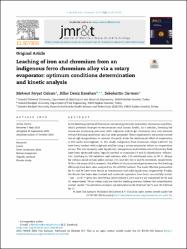| dc.contributor.author | Gülcan, Mehmet Feryat | |
| dc.contributor.author | Karahan, Billur Deniz | |
| dc.contributor.author | Gürmen, Sebahattin | |
| dc.date.accessioned | 2021-02-04T06:07:19Z | |
| dc.date.available | 2021-02-04T06:07:19Z | |
| dc.date.issued | 2020 | en_US |
| dc.identifier.citation | Gülcan, M. F., Karahan, B.D. ve Gürmen, S. (2020). Leaching of iron and chromium from an indigenous ferro chromium alloy via a rotary evaporator: Optimum conditions determination and kinetic analysis. Journal of Materials Research and Technology-JMR&T, 9(6), 14103-14115. https://doi.org/10.1016/j.jmrt.2020.09.133 | en_US |
| dc.identifier.issn | 2238-7854 | |
| dc.identifier.issn | 2214-0697 | |
| dc.identifier.uri | https://doi.org/10.1016/j.jmrt.2020.09.133 | |
| dc.identifier.uri | https://hdl.handle.net/20.500.12511/6503 | |
| dc.description.abstract | In the leaching process of chromium-containing precursor hexavalent chromium may form, which provokes damages to environment and human health. As a solution, leaching the chromium containing precursor with sulphuric acid to get chromium ions into solution without forming hexavalent ions has been proposed. These experiments are mostly carried out at high temperatures to increase the yield, while the detrimental effect of evaporation is still under investigation. In this study, indigenous ferro chromium alloys (>60 wt% Cr) have been leached with sulphuric acid by using a rotary evaporator where no evaporation occurs. The acid molarity, solid:liquid ratio, temperature and rotation rate of the rotary flask have been optimized using Taguchi method to maximize Fe and Cr dissolutions' efficiencies. Leaching in 5 M sulphuric acid solution with 1:50 solid:liquid ratio, at 90 degrees C, 30 rpm for 150 min could sustain yields around 73% and 56% for Cr and Fe recoveries, respectively. Within the scope of this research, the effects of the mentioned parameters on the leaching efficiency have been also analyzed via the ANOVA method. The most effective parameters for Cr and Fe have been found as temperature and solid:liquid ratio, respectively. Finally, the kinetic has been also studied and universal equations have been successfully tested. -ln(1 - x) = k*t(n) gives the best fitting result (where n = 0.4 and 0.6 are calculated for Fe and Cr, respectively). These values indicate that the leaching reaction follows the mixed kinetic control model. The activation energies are calculated as 46.12 kJ/mol for Fe and 142.8 kJ/mol for Cr. | en_US |
| dc.language.iso | eng | en_US |
| dc.publisher | Elsevier | en_US |
| dc.rights | info:eu-repo/semantics/openAccess | en_US |
| dc.rights | Attribution-NonCommercial-NoDerivatives 4.0 International | * |
| dc.rights.uri | https://creativecommons.org/licenses/by-nc-nd/4.0/ | * |
| dc.subject | Leach | en_US |
| dc.subject | Ferro Chromium Alloy | en_US |
| dc.subject | Rotary Evaporator | en_US |
| dc.subject | Taguchi Method | en_US |
| dc.subject | Kinetic Study | en_US |
| dc.title | Leaching of iron and chromium from an indigenous ferro chromium alloy via a rotary evaporator: Optimum conditions determination and kinetic analysis | en_US |
| dc.type | article | en_US |
| dc.relation.ispartof | Journal of Materials Research and Technology-JMR&T | en_US |
| dc.department | İstanbul Medipol Üniversitesi, Mühendislik ve Doğa Bilimleri Fakültesi, İnşaat Mühendisliği Bölümü | en_US |
| dc.department | İstanbul Medipol Üniversitesi, Rektörlük, Sağlık Bilim ve Teknolojileri Araştırma Enstitüsü | en_US |
| dc.authorid | 0000-0002-7839-2222 | en_US |
| dc.identifier.volume | 9 | en_US |
| dc.identifier.issue | 6 | en_US |
| dc.identifier.startpage | 14103 | en_US |
| dc.identifier.endpage | 14115 | en_US |
| dc.relation.ec | info:eu-repo/grantAgreement/TUBITAK/SOBAG/218M768 | |
| dc.relation.publicationcategory | Makale - Uluslararası Hakemli Dergi - Kurum Öğretim Elemanı | en_US |
| dc.identifier.doi | 10.1016/j.jmrt.2020.09.133 | en_US |
| dc.identifier.wosquality | Q1 | en_US |



















